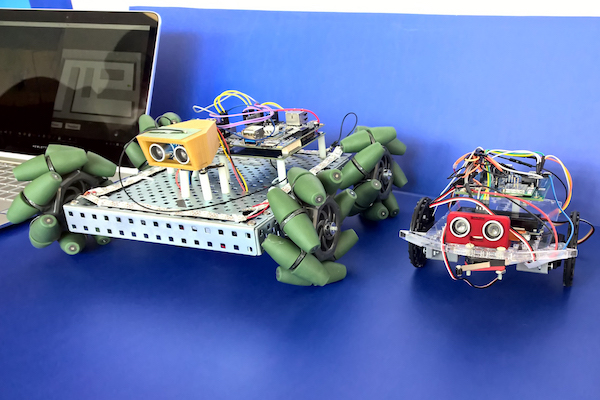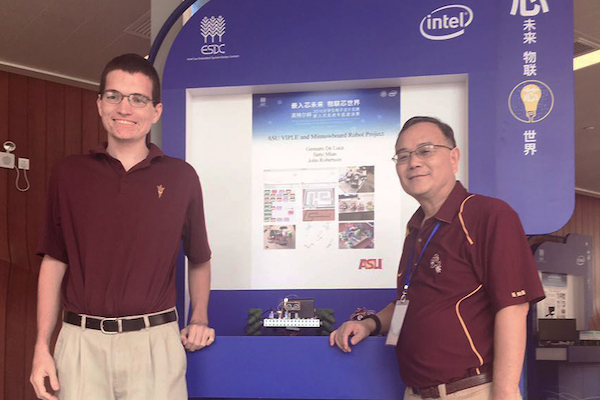
ASU team wins first prize at Intel Cup in China

The ASU VIPLE and Minnowboard Robot Project team continued a string of excellent performances at the Intel Cup by ASU students by winning their second straight first prize award. Photo courtesy: Yinong Chen.
The ASU VIPLE and Minnowboard Robot Project team continued a string of excellent performances at the Intel Cup by ASU students. ASU won a second prize in 2012 and now has first prizes in each of the past two competitions in 2014 and 2016.
The team consisted of four Ira A. Fulton Schools of Engineering students who graduated in the spring and were advised by Yinong Chen, a senior lecturer in the School of Computing, Informatics, and Decision Systems Engineering.
Sami Mian, a computer systems engineering major, was in charge of the hardware and designed the robots and all of the custom parts for the project. He was also an advisor on the 2012 team and helped with the hardware of that project. Gennaro De Luca, a computer science major, led the software team and developed the Visual IoT/Robotics Programming Language Environment software. John Robertson, an electrical engineering and computer science major, was in charge of the middleware that helped bring the other two teams together. Tara De Vries, a computer science major, worked in the software team. The members of the team are also members of the Sun Devil Robotics club that was founded by Mian and is advised by Chen.
The competition is held every two years and is jointly hosted by the Higher Education Department of the Ministry of Education and the Personnel Education Commission and Shanghai Jiaotong University and co-organized and sponsored by Intel.

Gennaro De Luca and team mentor Yinong Chen represented the team at the competition. Photo courtesy: Yinong Chen.
There were 160 teams that participated in this year’s competition that was held over two rounds. Forty-eight teams, including just eight from outside China, entered the final round held in Shanghai. A total of 13 first prize awards were given out, with ASU being the only team from outside of China to win one. Intel Cup rules dictate that teams in the top eight percent of competitors receive first prize honors. The competition aims to encourage improvement of the curriculum structure and content in the disciplines of information technology and electronics, promote implementation of well-rounded education within higher education institutions and to foster innovation skills among students.
They set out to create an alternate programming environment for the robotics concentration of CIDSE’s FSE 100 class. The team created a drag-and-drop visual programming language that they call VIPLE and also built a custom robot hardware kit for students to use. The robot is made of custom designed parts, Intel boards and middleware software they created themselves.
The project is an educational toolkit with multiple sub-parts, including VIPLE and a curriculum based on the FSE 100 curriculum that used the no longer supported Microsoft VPL.
“Our goal with VIPLE is to provide a language we can use to teach introductory level students computational thinking such as providing a focus on algorithms or higher level programming concepts without having to focus on the detailed syntax,” De Luca says. “We also developed the middleware that a user could install on an Intel board and be able to easily communicate with VIPLE and program that robot.”
The robots used in the project are just a single example of what students may build in the course to use the software. The team designed a robot toolkit so that students could quickly get started building and programming a robot as well as completing several tasks/projects, including autonomous maze navigation. In this way, students can learn about hardware, wiring and programming before learning any programming languages or advanced hardware skills.
Media Contact
Erik Wirtanen, [email protected]
480-727-1957
Ira A. Fulton Schools of Engineering



































